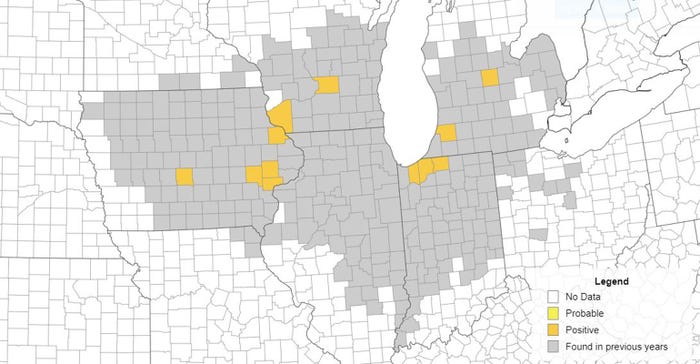
You might think it’s too early to scout for tar spot in corn, given that it was last August when it was first reported in Minnesota.
Think again.
As of mid-July, the fungal disease has already been found in corn in Iowa, Wisconsin, Illinois and Michigan. Plus, Minnesota’s corn planting season was earlier this spring.
“A lot of corn is tasseling now, so corn is susceptible,” says Dean Malvick, University of Minnesota plant pathologist.
Last growing season, tar spot was identified in cornfields in Faribault, Freeborn, Fillmore and Winona counties.
 LIMITED SPREAD: Tar spot was identified in four counties in Minnesota last year: Faribault, Freeborn, Winona and Fillmore. Extension specialists are asking farmers to begin scouting now for the fungal disease, noting that it could find its way into other counties besides these original four.
LIMITED SPREAD: Tar spot was identified in four counties in Minnesota last year: Faribault, Freeborn, Winona and Fillmore. Extension specialists are asking farmers to begin scouting now for the fungal disease, noting that it could find its way into other counties besides these original four.

Malvick wants to know if the fungal disease is emerging again and asks growers to scout their fields.
“We have little knowledge of tar spot in Minnesota,” he says. He expects it will not be limited to the areas where it was found in 2019.
“We have a lot to learn about it,” he adds. “Severity of the disease depends on hybrids, weather and crop stage. Fungicides can reduce tar spot, but they are a temporary solution.”
Tar spot is caused by the fungus Phyllachora maydis and has led to yield losses in the Midwest of up to 35 bushels per acre.
The disease appears as small, raised, black spots scattered on corn leaves and sometimes husks. Early in the season, you may only see a few black spots, compared to photos available online that show heavily speckled leaves.
Black spots can also be circled by brown tissue, giving it a fisheye-looking lesion. Tar spot is imbedded with plant tissue and cannot be scraped off.
Tar spot is known to overwinter in infested residue. It favors cool, wet environments, around 65 to 70 degrees F. Leaf wetness plays a key role in hosting the disease.
At this time, management options are limited to fungicides, which help reduce the severity of the disease. However, fungicide timing is important, Malvick adds, and offers a temporary solution.
 POSSIBLE FUNGICIDES: This list of fungicides for use on tar spot in corn was shared during a recent webinar hosted by University of Minnesota Crop Extension.
POSSIBLE FUNGICIDES: This list of fungicides for use on tar spot in corn was shared during a recent webinar hosted by University of Minnesota Crop Extension.

If you suspect tar spot, send leaf samples for diagnosis to the U-M Plant Disease Clinic in St. Paul. Label the sample as corn tar spot and include Malvick’s name so he will be notified about the results.
“Diagnosis of tar spot samples from Minnesota are free this year if growers also send an email to me with photos of the samples and a rough location of the field where they were collected,” Malvick says.
Questions? Email Malvick at [email protected]
Read more about:
Tar SpotAbout the Author(s)
You May Also Like






